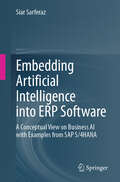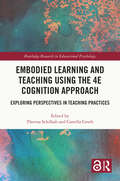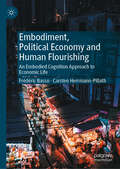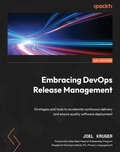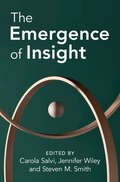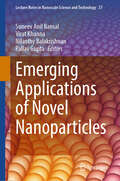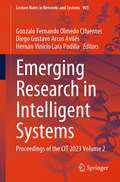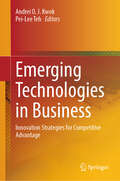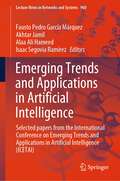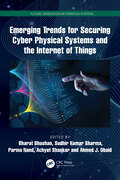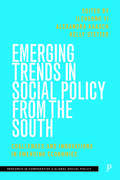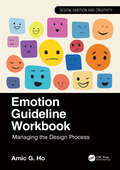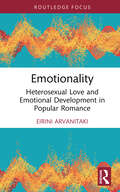- Table View
- List View
The Elton John Activity Book: An Unofficial Lovefest
by null Nathan JoyceRecognising one of the most-honoured performers of all time, The Elton John Activity Book is a celebration of a musical great. Perfect for the long-standing superfan or for those wanting to dive head-first into Elton’s world: this is a Sir Elton John lovefest. EGOT winner, Hollywood Royalty, philanthropist … there is nothing Sir Elton John has not excelled at. So much more than an artist, this extensive guides celebrates Sir Elton; his charitable work with Lady Diana, his place in the musical hall of fame, and features cameos from Elton's famous friendships such as Lady Gaga and the Beckhams! The Elton John Activity Book is a unique opportunity to learn all there is to know about Elton – and the perfect companion for fans across the world. Following the incredible career of Elton, as we: Brush up on the Wit & Wisdom from Sir Elton John, from how he created some of his greatest hits, to the joys of raising a family and even his journey to sobriety Enjoy gorgeous illustrations and bring them to life yourself by designing your own Elton Grand Piano, platform boots and even bedazzle Elton’s numberplate Relive some of his most famous interviews and check off Elton Bingo – making sure to keep an eye out for his wicked humour, favourite phrases and mentions of the talented and beloved Bernie Taupin Join some of Elton’s most famous friends for a game of Who Said That?! featuring Kate Bush, Eminem and Dusty Springfield Be inspired to write your own music with Elton's word clouds, pulling out the famous lyrics from Goodbye Yellow Brick Road, The Lion King and many more It’s time to be the last one still standing with this next exciting installment in Pavilion's activity book series.
Elusive: An electrifying retelling of the Scarlet Pimpernel packed with magic and vampires (The Scarlet Revolution #2)
by Genevieve CogmanRevolutionary France is full of blood and bite . . .1793. Eleanor, once a lowly English maid, is now a member of the League of the Scarlet Pimpernel: renowned for their daring deeds, and for rescuing aristocrats and vampires from the guillotine. When the notorious French diplomat Charles-Maurice de Talleyrand goes missing, Eleanor and the League leap into action. But they uncover two vampire factions feuding for control over humanity’s fate. Talleyrand’s disappearance is part of a larger, more dangerous scheme – one that threatens to throw France into bloody chaos . . .As the mutiny continues, a once-dead queen stalks the streets of Paris and the Scarlet Pimpernel is nowhere to be found. Eleanor must take control of her own fate. If she doesn’t, she may find herself the victim of the very people she came to save.The thrilling follow-up to Scarlet, Elusive by Genevieve Cogman is a witty, inventive retelling of the Scarlet Pimpernel, perfect for fans of The Invisible Library series, Kim Newman and Gail Carriger.'Utterly stunning. The intrigue and adventure keep you turning the page in this exciting tale of revolution, vampires and the guillotine' – T. L. Huchu, author of Library of the Dead, on Scarlet
Elusive Refuge: Chinese Migrants in the Cold War
by Laura MadokoroThe 1949 Chinese Communist Revolution is a subject of inexhaustible historical interest, but the plight of millions of Chinese who fled China during this tumultuous period has been largely forgotten. Elusive Refuge recovers the history of China’s twentieth-century refugees. Focusing on humanitarian efforts to find new homes for Chinese displaced by civil strife, Laura Madokoro points out a constellation of factors—entrenched bigotry in countries originally settled by white Europeans, the spread of human rights ideals, and the geopolitical pressures of the Cold War—which coalesced to shape domestic and international refugee policies that still hold sway today.Although the United States, Canada, Australia, New Zealand, and South Africa were home to sizeable Asian communities, Chinese migrants were a perpetual target of legislation designed to exclude them. In the wake of the 1949 Revolution, government officials and the broader public of these countries questioned whether Chinese refugees were true victims of persecution or opportunistic economic migrants undeserving of entry. It fell to NGOs such as the Lutheran World Federation and the World Council of Churches to publicize the quandary of the vast community of Chinese who had become stranded in Hong Kong.These humanitarian organizations achieved some key victories in convincing Western governments to admit Chinese refugees. Anticommunist sentiment also played a role in easing restrictions. But only the plight of Southeast Asians fleeing the Vietnam War finally convinced the United States and other countries to adopt a policy of granting permanent residence to significant numbers of refugees from Asia.
Embedding Artificial Intelligence into ERP Software: A Conceptual View on Business AI with Examples from SAP S/4HANA
by Siar SarferazThis book explains how to embed artificial intelligence in digitized business processes of ERP software by solving the two related substantial challenges: how can artificial intelligence be systematically integrated into ERP business processes for ease of consumption, and how can artificial intelligence be made enterprise-ready by covering ERP qualities like compliance, lifecycle management, extensibility, or scalability? As a general introduction, the first part of this book takes the reader through a historical journey towards intelligent ERP systems. In addition, reference processes and a reference architecture for ERP systems are proposed which build the foundation for the suggested subsequent solution concept, including a method for operationalizing intelligence for ERP business processes. Subsequently, in the second part detailed concepts of embedding artificial intelligence into ERP software are proposed. In this context the suggested solution architecture is depicted, and specific topics are resolved like data integration, model validation, explainability, data protection and privacy, model degradation and performance. In the last part an implementation framework is suggested which enables the previously introduced concepts and harmonizes the development and operations of artificial intelligent ERP applications. This part concludes with case studies considering artificial intelligence scenarios of SAP S/4HANA in the areas of logistics, finance and sales which apply the defined solution approach and shows its real-world feasibility. This book is written for professionals who want to implement (as developers) or exploit (as business analysts or consultants) or consider/plan the implementation/exploitation (as managers) of artificial intelligence in business information systems.
Embodied Learning and Teaching using the 4E Cognition Approach: Exploring Perspectives in Teaching Practices (Routledge Research in Educational Psychology)
by Theresa Schilhab Camilla GrothThis book operationalises the new field—EmLearning—that integrates embodiment and grounded cognition perspectives with education using the 4E approach as a guiding principle, which suggests that cognition is embodied, embedded, enacted, or extended.Chapters highlight empirical data, providing readers with research-based insight into the theoretical foundations of embodied cognition in learning, illustrated by practical examples. Ultimately, the volume contributes a radical understanding of embodied cognition, demonstrating the importance of the field to the educational system more broadly and suggesting a fundamental change to the way learning, education, and curriculum design are viewed and considered. Based on contemporary scientific findings, the book addresses the educational area with a focus on opening the embodied approach to a wider audience that will circulate the new knowledge and support their educational practices.Written with the purpose of contributing to a broad spectrum of academic educational fields, this book will be of use to postgraduates, researchers, and academics in the fields of higher education, educational psychology, teacher education, and teaching methodology and practice. Teachers and school politicians should also benefit from this volume more broadly.
Embodied Learning and Teaching using the 4E Cognition Approach: Exploring Perspectives in Teaching Practices (Routledge Research in Educational Psychology)
This book operationalises the new field—EmLearning—that integrates embodiment and grounded cognition perspectives with education using the 4E approach as a guiding principle, which suggests that cognition is embodied, embedded, enacted, or extended.Chapters highlight empirical data, providing readers with research-based insight into the theoretical foundations of embodied cognition in learning, illustrated by practical examples. Ultimately, the volume contributes a radical understanding of embodied cognition, demonstrating the importance of the field to the educational system more broadly and suggesting a fundamental change to the way learning, education, and curriculum design are viewed and considered. Based on contemporary scientific findings, the book addresses the educational area with a focus on opening the embodied approach to a wider audience that will circulate the new knowledge and support their educational practices.Written with the purpose of contributing to a broad spectrum of academic educational fields, this book will be of use to postgraduates, researchers, and academics in the fields of higher education, educational psychology, teacher education, and teaching methodology and practice. Teachers and school politicians should also benefit from this volume more broadly.
Embodiment, Political Economy and Human Flourishing: An Embodied Cognition Approach to Economic Life
by Carsten Herrmann-Pillath Frédéric BassoThis book presents embodied economics as a foundational alternative to behavioral economics and other projects integrating economics and psychology inspired by the computational paradigm. The 20th century witnessed the disembodiment of economic models through the intensification of mathematization and formal abstraction in economics. Even proponents of an embodied approach to cognition, such as Hayek, paradoxically championed the abstract market order as a disembodied superhuman intelligence. In the wake of groundbreaking perspectives in cognitive and social sciences, which have helped to rethink the fundamental building blocks of economics, agency and institutions, this title takes a radical turn towards embodiment. Reinstating economics as political economy, embodied economics motivates a critique of capitalism based on the analysis of disembodiment through abstraction and reactivates key critical insights into the anthropology put forward by the young Marx about contemporary economics and its conceptualizations of money, property, and labor. Based on this analysis, the authors envision a concrete utopia for an economic order centered on human dignity and care for life on Earth. This book contributes to recent discussions about behavioral, experimental and neuroeconomics and addresses a transdisciplinary audience in the social and behavioral sciences, philosophy, and the humanities.
Embodying Borders: A Migrant’s Right to Health, Universal Rights and Local Policies (EASA Series #41)
by Laura Ferrero, Chiara Quagliariello Ana Cristina VargasBased on extensive field research, the essays in this volume illuminate the experiences of migrants from their own point of view, providing a critical understanding of the complex social reality in which each experience is grounded. Access to medical care for migrants is a fundamental right which is often ignored. The book provides a critical understanding of the social reality in which social inequalities are grounded and offers the opportunity to show that right to health does not correspond uniquely with access to healthcare.
Embracing DevOps Release Management: Strategies and tools to accelerate continuous delivery and ensure quality software deployment
by Joel KrugerUnlock the power of DevOps release management to elevate your software development with early quality checks, testing, automation, and QA integration, reshaping your software delivery life cycle for excellenceKey FeaturesUnderstand the SDLC and the most popular release management modelsLearn what makes DevOps unique and how CI/CD pipelines enforce good DevOps release managementDrive a culture-driven release management initiative in your organization that breaks down silosPurchase of the print or Kindle book includes a free PDF eBookBook DescriptionAt the core of software development lies the imperative of swiftly and reliably releasing new features and updates, emphasizing the vital role of release management in the DevOps methodology. Discover how software development teams can elevate their processes by incorporating quality checks and shifting left, moving testing, automation, and QA procedures much earlier into the SDLC. However, release management is still tasked with application monitoring, overseeing infrastructure components, and managing change orders and schedules. This book offers insights into the essence of DevOps Release Management, illuminating its nuances and providing basic strategies for its implementation. You’ll explore how CI/CD pipelines enforce good DevOps release management and master techniques to optimize them. You’ll also learn how to foster a culture of cross-functional product development that minimizes waste and maximizes value to the customer. By the end of the book, you’ll have gained a comprehensive understanding of DevOps release management, its benefits, and practical implementation strategies. Equipped with this knowledge, you’ll be able to assess your own development processes and identify areas for improvement, ultimately leading to increased efficiency, collaboration, and value creation.What you will learnDiscover the significance and anatomy of the SDLCUnderstand the history of release management and how various models workGrasp DevOps release management and basic strategies to implement itConstruct optimized CI/CD pipelines capable of early issue detectionImplement the shift-left approach to enhance value delivery to customers at record speedFoster a culture of cross-functional collaboration in your teamMake DevOps release management pragmatic and accessibleOvercome common pitfalls in DevOps release managementWho this book is forThis book is a comprehensive introduction for those who are new to DevOps release management, but it's also valuable for DevOps engineers and release managers looking to enhance their skills and knowledge. If you’re looking to adopt key practices to shift left, this book will enable you to build high-quality products in record time.
The Emerald Handbook of Ethical Finance and Corporate Social Responsibility: A Framework for Sustainable Development
by AHMED IMRAN HUNJRA AND KHALED HUSSAINEYEthical finance involves financial practices that consider environmental, social, and governance (ESG) factors affecting a borrower and/or its assets. This approach extends beyond traditional financial metrics, aiming to align investments and lending with principles promoting sustainability, social responsibility, and effective governance. While previously confined to specialized finance providers and investors supporting environmentally or socially focused enterprises, this paradigm has shifted into the mainstream. According to the Global Ethical Finance Forum, the management of ethically driven assets worldwide has exceeded $27 trillion, indicating a growing recognition of the importance of integrating ESG factors and values into financial considerations. Individual and professional investors increasingly acknowledge the pivotal role played by ESG variables in determining risk and reward. In the evolving landscape of investment and finance, ethical standards have become the norm, offering crucial safeguards for informed investment and finance decisions. Instances where funds and lenders are perceived to neglect appropriate ESG considerations in their decision-making processes now face heightened scrutiny and questioning. The Emerald Handbook of Ethical Finance and Corporate Social Responsibility: A Framework for Sustainable Development presents a novel perspective on ESG considerations and the implementation of Corporate Social Responsibility (CSR) for sustainable development. This approach carries global and enduring implications.
The Emerald Handbook of Ethical Finance and Corporate Social Responsibility: A Framework for Sustainable Development
by Ahmed Imran Hunjra Khaled HussaineyEthical finance involves financial practices that consider environmental, social, and governance (ESG) factors affecting a borrower and/or its assets. This approach extends beyond traditional financial metrics, aiming to align investments and lending with principles promoting sustainability, social responsibility, and effective governance. While previously confined to specialized finance providers and investors supporting environmentally or socially focused enterprises, this paradigm has shifted into the mainstream. According to the Global Ethical Finance Forum, the management of ethically driven assets worldwide has exceeded $27 trillion, indicating a growing recognition of the importance of integrating ESG factors and values into financial considerations. Individual and professional investors increasingly acknowledge the pivotal role played by ESG variables in determining risk and reward. In the evolving landscape of investment and finance, ethical standards have become the norm, offering crucial safeguards for informed investment and finance decisions. Instances where funds and lenders are perceived to neglect appropriate ESG considerations in their decision-making processes now face heightened scrutiny and questioning. The Emerald Handbook of Ethical Finance and Corporate Social Responsibility: A Framework for Sustainable Development presents a novel perspective on ESG considerations and the implementation of Corporate Social Responsibility (CSR) for sustainable development. This approach carries global and enduring implications.
The Emergence of Insight
by Carola Salvi Jennifer Wiley Steven M. SmithWe are all familiar with the feeling of being stuck when a problem we are faced with seems intractable and we are unable to find a solution. But sometimes, a new way of seeing the problem pops into the mind from out of the blue. The missing piece of the puzzle is found, the gap is filled, and the solution is now obvious. This is the insight experience - the Aha! Moment - which has been a source of fascination to those who study problem solving for centuries. Written by leading researchers from around the world, this volume explores cutting-edge perspectives on insight, the processes that underlie it, and the conditions that promote it. Chapters draw on key themes: from attention, to memory and learning, to evolutionary perspectives. Students and researchers in applied, cognitive, and educational psychology, as well as those studying creativity, insight, and cognitive neuroscience, will benefit from these perspectives.
Emergency
by Daisy HildyardEmergency is a novel about the dissolving boundaries between all life on earth. Stuck at home alone under lockdown, a woman recounts her 1990s childhood in rural Yorkshire. She watches a kestrel hunting, helps a farmer with a renegade bull, and plays out with her best friend, Clare. Around her in the village her neighbours are arguing, keeping secrets, caring for one another, trying to hold down jobs. In the woods and quarry there are foxcubs fighting, plants competing for space, ageing machines, and a three-legged deer who likes cake. These local phenomena interconnect and spread out from China to Nicaragua as pesticides circulate, money flows around the planet, and bodies feel the force of distant power. A story of remote violence and a work of praise for a persistently lively world, brilliantly written, surprising, evocative and unsettling, Daisy Hildyard's Emergency reinvents the pastoral novel for the climate change era.
An Emergency Physician’s Path: What to Expect After an Emergency Medicine Residency
by Robert P. Olympia Elizabeth Barrall Werley Jeffrey S. Lubin Kahyun Yoon-FlanneryA career in emergency medicine can be truly rewarding, despite the long hours and adverse conditions. The decision to embark on this journey typically starts during medical school, usually with the allure of resuscitations and life-saving procedures performed in the fast-paced environment of the emergency department. During an emergency medicine residency, the young physician is faced with career decisions that may involve working in a community or academic emergency department setting, or pursuing specialization through fellowship. Following residency and fellowship training, the emergency physician may decide to purely work clinically in an emergency department, or combine clinical responsibilities with administrative, education or research pursuits. This unique text provides medical students, residents, fellows and attending physicians with a comprehensive guide to be successful in a career in emergency medicine. Sections include the history of emergencymedicine, choosing a career in emergency medicine from a medical student’s point of view, pursuing fellowship and additional training, community and academic careers in emergency medicine, career options in emergency medicine, critical skills in emergency medicine, research/scholarship, being a teacher, and carving a path in emergency medicine. All chapters are written by experts in the field, representing emergency departments throughout North America.
Emerging Applications of Novel Nanoparticles (Lecture Notes in Nanoscale Science and Technology #37)
by Suneev Anil Bansal Virat Khanna Nilanthy Balakrishnan Pallav GuptaThis book is a comprehensive and modern guide on emerging nanoparticles and their diverse applications in engineering, medicine, food safety, transportation, energy, agriculture, and environmental sustainability. Written by leading researchers from all over the world, it is designed to cover the full range of nanoparticles as well as provide in-depth detail regarding their development, characterization, processing, and synthesis. The book is divided into two sections: the first covers the development of advanced nanoparticles and the second is dedicated to their variety of cutting-edge applications. The authors also cover the unique properties and green synthesis of nanoparticles as well as their use as nanobiosensors, nanopesticide, nanofertilizer, and as energy storage and conversion devices, just to name a few. This book provides readers with insight onto the broad scope of computational, theoretical, and experimental research on novel nanoparticles and their applications. It is ideal for both young and experienced researchers and industry professionals in the field of nanotechnology.
Emerging Research in Intelligent Systems: Proceedings of the CIT 2023 Volume 2 (Lecture Notes in Networks and Systems #903)
by Gonzalo Fernando Olmedo Cifuentes Diego Gustavo Arcos Avilés Hernán Vinicio Lara PadillaThis book covers different aspects of advances in research, technological development, and innovation results in artificial intelligence, computational modeling, electrical, electronics, telecommunication, data communications, defense engineering, innovation, technology and society, managing technology and sustained innovation, business development, security and cryptography, and software engineering. In addition, the volume focuses on research results focused on finding innovative solutions in intelligent systems concerning the topics mentioned above, which are developed in national and international postgraduate programs and associated research groups and networks. This book interests the industry, teachers, undergraduate and graduate students, and researchers working in intelligent systems, security and defense, and technological, human, and administrative sciences.
Emerging Technologies in Business: Innovation Strategies for Competitive Advantage
by Andrei O. J. Kwok Pei-Lee TehThis book is a collection of studies that explores the adoption, applications, and implications of emerging technologies in business. Given that emerging technologies have the potential to significantly disrupt and transform existing business models, the premise is to demonstrate how theories are translated into practice. Readers will gain insights into operating processes and business models, the diffusion of innovation in business and industry, and how humans interact with emerging technologies.
Emerging Trends and Applications in Artificial Intelligence: Selected papers from the International Conference on Emerging Trends and Applications in Artificial Intelligence (ICETAI) (Lecture Notes in Networks and Systems #960)
by Fausto Pedro García Márquez Akhtar Jamil Alaa Ali Hameed Isaac Segovia RamírezThe book covers the proceedings of the International Conference on Emerging Trends and Applications in Artificial Intelligence (ICETAI) held at Istanbul Medipol University, Turkey, on 24 – 25 August 2023. It presents a comprehensive compilation of papers covering the forefront of artificial intelligence, encapsulating state-of-the-art models, innovative methodologies applied to benchmark datasets, and incisive analyses addressing contemporary challenges. Encompassing four pivotal tracks—Artificial Intelligence and Machine Learning, Big Data and Cloud Computing, Internet of Things and Sensor Technology, and Applications of Artificial Intelligence—this volume serves as a vital resource for researchers, scholars, and professionals navigating the multifaceted landscape of AI advancements and their real-world applications across diverse domains.
Emerging Trends for Securing Cyber Physical Systems and the Internet of Things (Future Generation Information Systems)
by Bharat Bhushan Sudhir Kumar Sharma Parma Nand Achyut Shankar Ahmed J. ObaidIn the past decades, cyber-physical systems (CPSs) have been widely applied to fields such as smart grids, environment monitoring, aerospace, smart transportation, and industrial automation. Great strides have been made in CPSs to improve the computing mechanism, communication, and quality of service by applying optimization algorithms. Currently, these efforts are integrated with the applications of machine learning (ML) and artificial intelligence (AI). To maintain system reliability and stability, CPSs such as smart grids face numerous challenges, including large-scale Internet-of-Things (IoT) device adaptation, ever-increasing demands of electrical energy, and the rise of a wide range of security threats. These challenges bring forth the need to find sustainable and advanced solutions to guarantee reliable and secure operations in these systems.The goal of this book is to foster transformative, multidisciplinary, and novel approaches that ensure CPS security by taking into consideration the unique security challenges present in the environment. This book attracts contributions in all aspects pertaining to this multidisciplinary paradigm, which includes the development and implementation of Smart CPS, Supervisory Control and Data Acquisition (SCADA) systems, CPS for Industry 4.0, CPS architecture for IoT applications, and CPS forensics.This book: Discusses concepts including wireless sensor networks (WSNs), CPSs, and the IoT in a comprehensive manner. Covers routing protocols in sensor networks, attacks, and vulnerabilities in WSNs, the Internet of Cyber-Physical Things, and CPSs for industrial applications. Highlights technological advances, practical solutions, emerging trends, and prototypes related to privacy in CPSs and the IoT. Presents a pathway and architecture for proactive security schemes in CPSs to counter vulnerabilities, including phishing attacks, malware injection, internal stealing of data, and hacking. Discusses the most recent research and development on the enabling technologies for IoT-based CPSs. Owing to the scope and diversity of topics covered, the book will be of interest not only to researchers and theorists but also to professionals, material developers, technology specialists, and methodologists dealing with the multifarious aspects of data privacy and security enhancement in CPSs. The book will provide these professionals an overview of CPS security and privacy design, as well as enlighten them to promising solutions to research problems such as cyberattacks in CPS, risk identification and management in CPS, ML-based trust computational models for CPSs, nature-inspired algorithms for CPSs, and distributed consensus algorithms for event detection in CPSs. The secondary target audience of this book includes legal practitioners, hackers, cyber law policymakers, cyber forensic analysts, and global security consortiums who may use it to further their research exposure to pertinent topics in cybersecurity.
Emerging Trends for Securing Cyber Physical Systems and the Internet of Things (Future Generation Information Systems)
In the past decades, cyber-physical systems (CPSs) have been widely applied to fields such as smart grids, environment monitoring, aerospace, smart transportation, and industrial automation. Great strides have been made in CPSs to improve the computing mechanism, communication, and quality of service by applying optimization algorithms. Currently, these efforts are integrated with the applications of machine learning (ML) and artificial intelligence (AI). To maintain system reliability and stability, CPSs such as smart grids face numerous challenges, including large-scale Internet-of-Things (IoT) device adaptation, ever-increasing demands of electrical energy, and the rise of a wide range of security threats. These challenges bring forth the need to find sustainable and advanced solutions to guarantee reliable and secure operations in these systems.The goal of this book is to foster transformative, multidisciplinary, and novel approaches that ensure CPS security by taking into consideration the unique security challenges present in the environment. This book attracts contributions in all aspects pertaining to this multidisciplinary paradigm, which includes the development and implementation of Smart CPS, Supervisory Control and Data Acquisition (SCADA) systems, CPS for Industry 4.0, CPS architecture for IoT applications, and CPS forensics.This book: Discusses concepts including wireless sensor networks (WSNs), CPSs, and the IoT in a comprehensive manner. Covers routing protocols in sensor networks, attacks, and vulnerabilities in WSNs, the Internet of Cyber-Physical Things, and CPSs for industrial applications. Highlights technological advances, practical solutions, emerging trends, and prototypes related to privacy in CPSs and the IoT. Presents a pathway and architecture for proactive security schemes in CPSs to counter vulnerabilities, including phishing attacks, malware injection, internal stealing of data, and hacking. Discusses the most recent research and development on the enabling technologies for IoT-based CPSs. Owing to the scope and diversity of topics covered, the book will be of interest not only to researchers and theorists but also to professionals, material developers, technology specialists, and methodologists dealing with the multifarious aspects of data privacy and security enhancement in CPSs. The book will provide these professionals an overview of CPS security and privacy design, as well as enlighten them to promising solutions to research problems such as cyberattacks in CPS, risk identification and management in CPS, ML-based trust computational models for CPSs, nature-inspired algorithms for CPSs, and distributed consensus algorithms for event detection in CPSs. The secondary target audience of this book includes legal practitioners, hackers, cyber law policymakers, cyber forensic analysts, and global security consortiums who may use it to further their research exposure to pertinent topics in cybersecurity.
Emerging Trends in Social Policy from the South: Challenges and Innovations in Emerging Economies
by Ilcheong Yi, Alexandra Kaasch and Kelly StetterDrawing on international case studies from emerging economies and developing countries including South Africa, India, Egypt, Morocco, Jordan, Tunisia, Indonesia, China and Russia, this book examines the rise, nature and effectiveness of recent developments in social policy in the Global South. By analysing these new emerging trends, the book aims to understand how they can contribute to meaningful change and whether they could offer alternative solutions to the social, economic and environmental policy challenges facing low-income countries within a contemporary global context. It pays particular attention to reforms and innovations relating to the objectives of the 2030 Agenda for Sustainable Development, including the move away from a welfare state, towards a ‘welfare multitude’, in which new actors, such as civil society organisations, play an increasingly important role in social policy.
Emerging Trends in Social Policy from the South: Challenges and Innovations in Emerging Economies
by Ilcheong Yi Alexandra Kaasch Kelly StetterDrawing on international case studies from emerging economies and developing countries including South Africa, India, Egypt, Morocco, Jordan, Tunisia, Indonesia, China and Russia, this book examines the rise, nature and effectiveness of recent developments in social policy in the Global South. By analysing these new emerging trends, the book aims to understand how they can contribute to meaningful change and whether they could offer alternative solutions to the social, economic and environmental policy challenges facing low-income countries within a contemporary global context. It pays particular attention to reforms and innovations relating to the objectives of the 2030 Agenda for Sustainable Development, including the move away from a welfare state, towards a ‘welfare multitude’, in which new actors, such as civil society organisations, play an increasingly important role in social policy.
Emotion Guideline Workbook: Managing the Design Process (Design, Emotion and Creativity)
by Amic G. HoManipulating the design process can be challenging for junior design, art and creative students. Besides understanding the approaches to managing the design factors with logical thinking, they can lack experience in handling emotional changes and concerns and initiative factors during the design process. As a result, they struggle to practice design and need guidance for enhancing their decision-making, evaluation, judgment, and motivation.This book proposes a set of guiding principles with the intention of assisting the reader in regulating the emotional changes that occur throughout the design process. This book offers practical approaches to those who would like to incorporate emotion in their design processes, which contrasts with previous scholarly research that has mostly focused on the theoretical level. It provides guidance to the reader through the process of adapting to the emotional changes that may occur throughout the design process during their design studies. It contains a literature review, research methods and a discussion of the strengths and limitations. Featuring printable worksheets and additional tables to use as guidance, this highly practical text allows the reader to gain a full understanding of emotion in the design procedure through active involvement process.The Emotion Guideline Workbook is perfect for design, art and creative students, as well as their instructors, researchers, and other learners who are interested in emotion-driven design. It will also appeal to students and academics in the fields of psychology and education.
Emotion Guideline Workbook: Managing the Design Process (Design, Emotion and Creativity)
by Amic G. HoManipulating the design process can be challenging for junior design, art and creative students. Besides understanding the approaches to managing the design factors with logical thinking, they can lack experience in handling emotional changes and concerns and initiative factors during the design process. As a result, they struggle to practice design and need guidance for enhancing their decision-making, evaluation, judgment, and motivation.This book proposes a set of guiding principles with the intention of assisting the reader in regulating the emotional changes that occur throughout the design process. This book offers practical approaches to those who would like to incorporate emotion in their design processes, which contrasts with previous scholarly research that has mostly focused on the theoretical level. It provides guidance to the reader through the process of adapting to the emotional changes that may occur throughout the design process during their design studies. It contains a literature review, research methods and a discussion of the strengths and limitations. Featuring printable worksheets and additional tables to use as guidance, this highly practical text allows the reader to gain a full understanding of emotion in the design procedure through active involvement process.The Emotion Guideline Workbook is perfect for design, art and creative students, as well as their instructors, researchers, and other learners who are interested in emotion-driven design. It will also appeal to students and academics in the fields of psychology and education.
Emotionality: Heterosexual Love and Emotional Development in Popular Romance (Routledge Focus on Literature)
by Eirini ArvanitakiThis book focuses on the projections of romantic love and its progression in a selection of popular romance novels and identifies an innovation within the genre’s formula and structure. Taking into account Giddens’s notion of ‘confluent’ love, this book argues that two forms of love exist within these texts: romantic and confluent love. The analysis of these love variants suggests that a continuum emerges which signifies the complexity but also the formation and progressive nature of the protagonists’ love relationships. This continuum is divided into three stages: the pre-personal, semi-personal, and personal. The first phase connotes the introduction of the protagonists and describes the sexual attraction they experience for each other. The second phase refers to the initiation of the sexual interaction between the heroine and hero without any emotional involvement. The third and final phase begins when emotions such as jealousy, shame/guilt, anger, and self-sacrifice are awakened and acknowledged.



